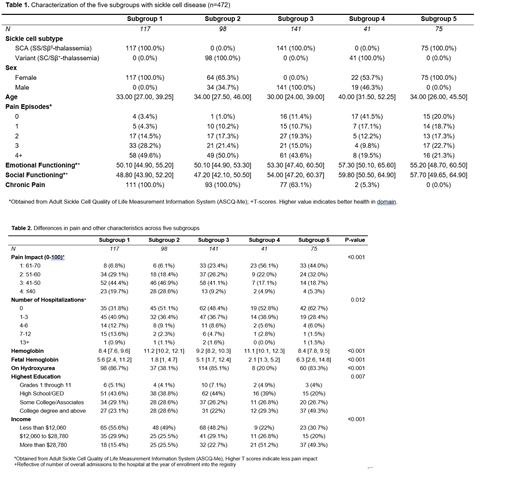Introduction: Sickle cell disease (SCD) affects millions worldwide and is characterized by episodic severe pain, impacting quality of life and leading to significant healthcare utilization. Yet, clinicians face significant challenges in treating pain in individuals with SCD due to heterogeneity in pain experiences and pain impact. Improved understanding of the clinical characteristics of individuals with SCD who are at risk for developing severe pain is necessary to better manage pain and develop novel and personalized pain interventions. The objectives of this study were to (1) identify distinct pain subgroups based on demographic and psychosocial characteristics and (2) evaluate the relationship between the subgroups and pain impact.
Methods: We performed a hierarchical cluster analysis on a cross-sectional sample of adults living with SCD enrolled in the Global Research Network Data and Discovery (GRNDaD) registry who had completed the Adult Sickle Cell Quality of Life Measurement Information System (ASCQ-Me) surveys. Classification variables for clustering included SCD subtype (SS/Sβ 0-thalassemia [SCA] vs SC/Sβ +-thalassemia [variant]), sex, age, presence of chronic pain, frequency of SCD pain episodes, and social and emotional functioning.
Results: There were 472 adult participants included in the analysis. The overall sample was 59% female with a median age of 33 (IQR 26-42 years). Five distinct subgroups were identified: Subgroup 1 (n=117, 100% SCA subtype, 100% female, median age 33, high chronic pain and pain episodes, and poor social and emotional functioning), Subgroup 2 (n=98, 100% variant subtype, 65% female, median age 34, high chronic pain and pain episodes, poor social and emotional functioning), Subgroup 3 (n=141, 100% SCA, 100% male, median age 30, moderate chronic pain, high pain episodes, and low-normal social and emotional functioning), Subgroup 4 (n=41, 100% variant, 54% female, median age 40, low chronic pain and pain episodes, normal social and emotional functioning), and Subgroup 5 (n=75, 100% SCA, 100% female, median age 34, no chronic pain, low pain episodes, and normal social and emotional functioning). All subgroups differed significantly (p<0.05) with respect to pain impact/interference, with Subgroups 1-3 demonstrating worse pain impact. Additionally, significant differences in hospitalization, education and income, total hemoglobin and fetal hemoglobin levels were noted between the subgroups. Hydroxyurea use was similar in the three clusters with SCA (subgroups 1 and 2).
Conclusion: To our knowledge, this analysis represents the largest pain subgroup analysis in SCD. Subgroups with worse pain impact were characterized by poorer social and emotional functioning, implying that psychosocial factors are strongly associated with pain outcomes in individuals with SCD. Moreover, variations in pain impact based on sex and SCD subtype suggest these factors are associated with differences in pain outcomes. Additionally, we found that the presence of chronic pain is associated with higher pain impact, increased healthcare utilization, and more frequent pain episodes. The study should be interpreted with consideration of the following limitations: (1) cross-sectional design, which limits the ability to establish causality or directionality between the various associations, and (2) reliance on self-reported measures that may be subject to recall and reporting biases. Nevertheless, these findings highlight the heterogeneity in pain experiences and suggest that multimodal interventions may be critical in addressing the pain and psychosocial burden for individuals with SCD. Longitudinal studies are needed to further validate these findings and explore how pain profiles may change over time in individuals with SCD.
Disclosures
Kenney:Global Therapeutics/Pfizer: Research Funding. Lanzkron:HRSA: Research Funding; Global Blood Therapeutics: Research Funding; Novartis: Consultancy, Research Funding; Imara/Enliven Therapeutics: Research Funding; Novo Nordisk: Consultancy; Teva Pharmaceutical Industries: Current equity holder in publicly-traded company; Bluebird Bio: Consultancy; PCORI: Research Funding; CSL-Behring: Research Funding; Magenta: Consultancy; National Alliance for Sickle Cell Centers: Other: Vice president ; Takeda: Research Funding; Pfizer: Consultancy. Kanter:Fulcurm: Consultancy; ECOR-1: Consultancy; Novo Nordisk: Research Funding; Chiesi: Consultancy, Membership on an entity's Board of Directors or advisory committees; Glycomimetics: Membership on an entity's Board of Directors or advisory committees; Guidepoint Global: Honoraria; Bausch: Consultancy; Novartis: Consultancy, Membership on an entity's Board of Directors or advisory committees, Research Funding; HRSA: Research Funding; Bluebird Bio: Consultancy, Membership on an entity's Board of Directors or advisory committees, Research Funding; Vertex: Consultancy; Takeda: Research Funding; BEAM: Consultancy, Research Funding; CDC: Research Funding; NHLBI: Research Funding; Austin Pharmaceuticals: Consultancy, Membership on an entity's Board of Directors or advisory committees; Watkins, Lourie, Roll & Chance: Consultancy; National Alliance of Sickle Cell Centers: Other: President. Manwani:Novartis, Pfizer, Novo Nordisk, Editas, GBT: Consultancy. Little:bluebird bio: Consultancy; NASCC: Research Funding; Biochip Labs: Patents & Royalties: Make no profit; FORMA: Other: Adjudication committee for Hibiscus study; USC: Research Funding; NHLBI: Honoraria; Hemex: Patents & Royalties: Make no profit; GBT: Research Funding; Novo Nordisk: Consultancy; Pfizer: Consultancy; American Society of Hematology: Research Funding.


This feature is available to Subscribers Only
Sign In or Create an Account Close Modal